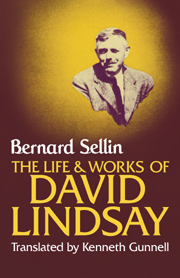Book contents
- Frontmatter
- Contents
- Acknowledgements
- Foreword by Colin Wilson
- Author's preface
- Translator's preface
- Introduction
- 1 The life and personality of the author
- 2 Backgrounds, settings and places
- 3 The human world
- 4 The world of Crystalman
- 5 The Sublime world
- 6 The Violet Apple and The Witch
- Conclusion
- Notes
- Bibliography
- Index
2 - Backgrounds, settings and places
Published online by Cambridge University Press: 18 September 2009
- Frontmatter
- Contents
- Acknowledgements
- Foreword by Colin Wilson
- Author's preface
- Translator's preface
- Introduction
- 1 The life and personality of the author
- 2 Backgrounds, settings and places
- 3 The human world
- 4 The world of Crystalman
- 5 The Sublime world
- 6 The Violet Apple and The Witch
- Conclusion
- Notes
- Bibliography
- Index
Summary
We now know what kind of man David Lindsay was. His entire personality is a microcosm of his work. It has been seen that his career as a writer was, to a large degree, an escape from an environment that he found far from agreeable. Accordingly, it is both tempting and logical to begin any study of Lindsay's work with a detailed consideration of the settings he chose for his novels; what they are, how he presents them to us, and how, as a writer, he relates them to reality.
NATURE
Far from being just a prop for the action, Nature plays an important role in Lindsay's work. The background of his novels is Nature, and, between the human world and Nature, strange relationships appear. This presence of Nature has a definite purpose. Behind it can be seen the author's love of Nature. Lindsay loved plants, and was passionately fond of gardening. He adored walking over the Sussex Downs or the Cornish hills. In London, the author felt unhappy, and, whenever he could, he isolated himself in the country, making only rare trips into town. Nature, along with its corollary, solitude, was, in his case, an essential condition for artistic creation, and it was to the hills of Dartmoor that he went to seek inspiration for one of his novels, Devil's Tor. His wife shared his admiration for the work of the naturalist, W. H. Hudson, and especially for his novel, Green Mansions.
- Type
- Chapter
- Information
- The Life and Works of David Lindsay , pp. 60 - 98Publisher: Cambridge University PressPrint publication year: 1981



